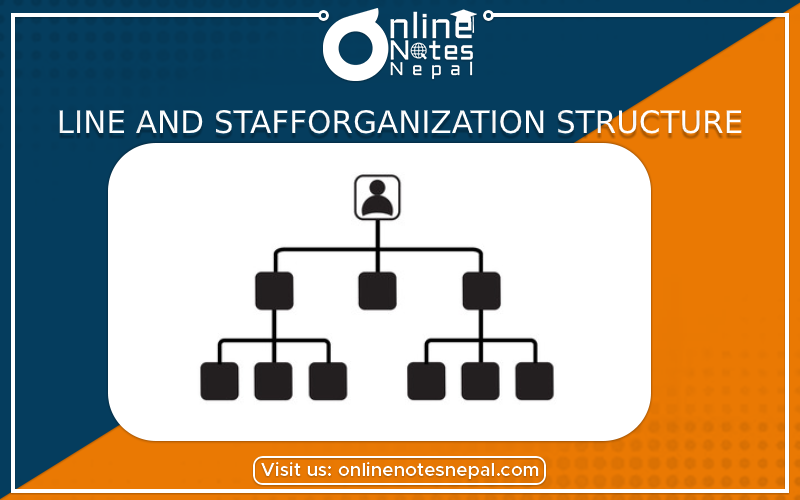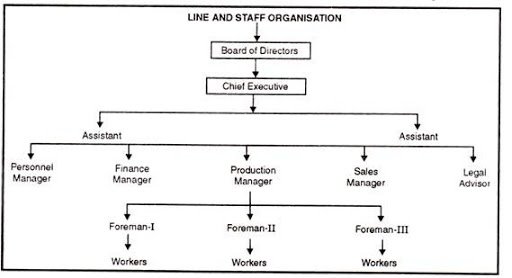Published by: Zaya
Published date: 07 Jun 2021

In line and staff organization, there is a provision of a chain of commands as in line organizations, and besides, there is a functional specialist. In a simple sense, line and staff organization are the outcomes of the positive sides of both line and functional organizations. It has been developed to strike a balance between the unity of command and functional specializations.
Thus, line and staff organization is the combination of line and functional organizations. Functional specialists contribute to making plans and the line manager is responsible for the implementation of plans in the practical field. This organization is designed to overcome the limitations of both the line organization and functional organization structure.

The following are some points of advantages of line and staff organization:
1. Managerial specialization
Inline and staff organization, the work of the organization is divided among the line authorities. Line authorities are efficient in their sector of business and are also responsible for the completion of given work. Besides, they get suggestions, guidance, and advice from functional specialists in accordance with the requirement.
2. Better coordination
Coordination among all personnel of the organization is one of the advantages of line and staff organization. Line authorities involve implementing plans and maintaining control over activities. In a similar way, functional authorities involved in providing guidance and suggestions to line authorities. This helps in maintaining better coordination among members of the organization.
3. Limited functional authority
The line authorities are given authority to exercise control over the subordinates of their own line departments. The provision of such functional authority in one way saves the time of the general manager, and in another, facilities quick and efficient implementation of instructions.
4. Practical decision
The right decision at the right time is essential for business success. In the structure, the top management and line authorities are responsible for the decision. They can take better decisions by taking suggestions and information from functional staff members. This helps in maintaining a balance between various activities of the organization.
5. Facilitates growth
The line and staff organization structure facilitates growth and helps develop the business activities of the enterprise. Here, both line and functional authorities work jointly in achieving organizational objectives. An enterprise can expand its business and can diversify its lines of business in accordance with the scope and financial benefits.
6. Better utilization of resources
Better utilization of the available resource is essential for the successful attainment of organizational objectives. This facilities better utilization of organizational resources including manpower. Hence, both line and staff officials perform their functions through mutual cooperation and coordination.
7. Greater flexibility
This organizational structure provides a better scope for flexibility. Newline departments can be created on the basis of requirements. Line authority and subordinates can be appointed in the departments concerned. In a similar way, the management can modify the authority and responsibilities of the employee according to requirements.
The following are some disadvantages of line and staff organization:
1. Problem of conflict
One of the limitations of line and staff organization is the problem of conflict between line and staff authorities. This problem creates a tense environment and puts a question mark on the development of the working efficiency of the organizations. The top-level management has to exercise more power to maintain coordination among the members.
2. Greater confusion
The line and staff organization creates confusion in the minds of the manager, subordinates, and also among line and staff authorities. The lack of demarcation of authority and responsibility between line and staff authorities creates confusion among them. It creates greater confusion among the subordinates as to whom they are responsible.
3. High-cost structure
The line and staff organization need more administration costs. This structure needs two types of executives- line and staff. Line authorities are efficient in their own line of business and, as such, they expect more remuneration. Meanwhile, functional specialists are to be paid more.
4. Over-dependence on staff
In some situations, line executives may be over-dependent on staff members for information and suggestions. In a similar way, they make plans in accordance with functional specialists and implement plans according to their own creativity, initiative, and judgment.
5. Inefficient staff
Functional specialists have no formal right to take an active part in the preparation and implementation of plans. Their role is limited only to providing advice and suggestions to line authorities. Whether or not to accept their suggestions depends upon line authorities.
6. Lack of responsibility
Line managers may depend too much on functional specialists. Line managers may even implement plans in accordance with functional specialists' advice and suggestions. In such a situation, line authorities may lose their commitment and creativity. Generally, staff specialists are not accountable for the execution of plans and results of the organizations.
7. Complication for management
It is more difficult to coordinate and manage both line and staff authorities, as both may have a negative attitude towards each other. In some situations, the top management is confused about handling lines and staff authorities. This becomes a serious problem for management, especially, in emergency situations.